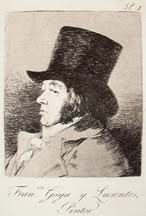10.02.03
by Michael Swanwick
with illustrations by
Francisco José de Goya y Lucientes

Click image to enlarge Digital image © copyright
|
80. [Plate 1] The captions that Goya wrote to The Disasters of War tug at the heart and chill the soul. They are cries of horror and despair by one who may well have witnessed such atrocities. "No one can look" reads one caption. A field of corpses elicits "Bury them and shut up." An etching showing three soldiers casually, brutally strangling a partisan reads simply Por qué? "Why?" No sane person would attempt to write stories for such images. Los Caprichos, the etchings in this book, are a different matter. They show climactic moments in larger dramas left unexplained. The captions are oblique and idiomatic. The accompanying "explanations," of uncertain authority, are trivial and frivolous. They put voice to conventional morality. Some seem even to have been misplaced, for they do not describe what the viewer sees printed alongside them. They reek of complacency, as the etchings do not. | ||||
|
Feeling that the Caprichos deserved better, I wrote the stories you have just read. In some cases I am confident that I discovered Goya's original intent. The oversized syringe in Plate 58, for instance, is surely a clyster, and the monk wielding it has clearly just received a dose of his own medicine. Mostly, however, I imposed my own interpretations upon the etchings. That some of my targets did not exist in Goya's time is a superficiality. The range of human folly has not changed any in the past two centuries. If you were to ask what right I had to put words to Goya's images, I would reply: As little as Goya had to make them in the first place. Neither Goya nor I was in a position to alter the history of our times. He was but a painter, and I a writer. Look for us a hundred years later, and you will find no record of how we lived or what we thought, other than our work alone. Such is the common lot of humanity. Each human life defines an age. It begins with a birth and ends with a death. In the interim one lives and loves, suffers and learns, and comes to accept the inevitable losses. Children appear and parents vanish. The world shifts like banks of clouds. The best you can do in the transitory moment is to speak the truth as you see it. So it was in the age of Goya. So it is in the age of Swanwick.
This is the last of 80 stories by Michael Swanwick written to accompany Francisco Goya's Los Caprichos. For a listing of all the stories, go to The Sleep of Reason. |
||||
home | stories | columns | archive | faq | talk
Stories and articles © copyright 2001, 2002, 2003 by the original authors.
Illlustrations © copyright 2001, 2002, 2003, by the original illustrators.
Site graphics, logo, and html coding © copyright 2001, 2002, 2003, by Eileen K. Gunn.
All other material © copyright 2001, 2002, 2003, by Eileen K. Gunn.
All rights reserved.
Founding sponsor: Matrix.Net
-->
